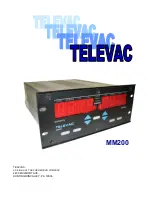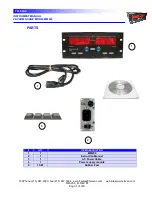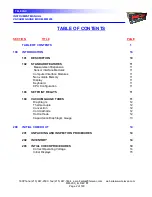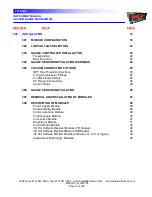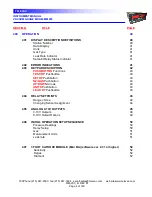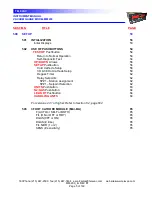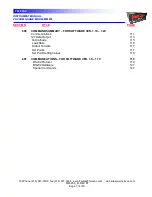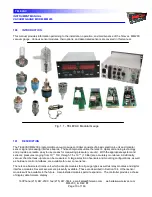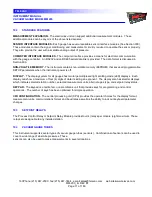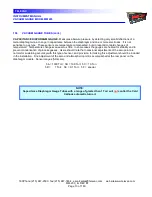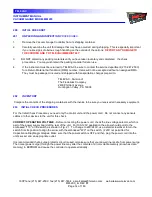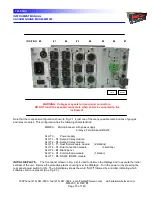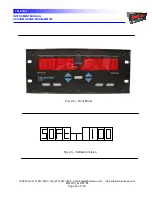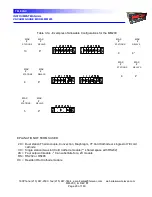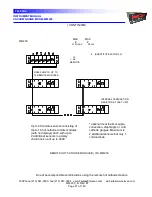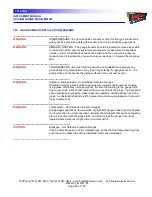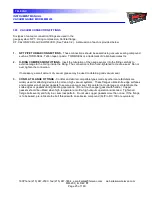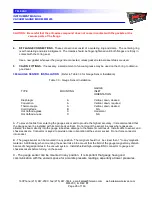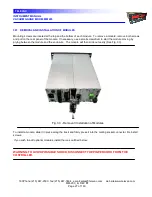
INSTRUMENT MANUAL
VACUUM GAUGE MODEL MM200
160Phone:(215) 947-2500 fax:(215) 947-7464 e-mail:[email protected] web site:www.televac.com
MM-200_im REV M
Page 12 of 160
TELEVAC
104
VACUUM
GAUGE TUBES (cont.)
DIAPHRAGM GAUGE
- Measures absolute pressure by detecting very small deflections of a metal diaphragm via
a strain gauge. It is not sensitive to gas type. These sensors are temperature compensated, but do respond to
rapid changes of temperature. Temperature changes cause zero shifts. Users should note that occasional
adjustments of the zero point are normal for sustaining accuracy with this type of sensor, and provision for making
this adjustment should be included in the installation. Fine adjustment of the zero and atmospheric point is
accomplished at the rear panel on the diaphragm module. Sensor range: 1E: 1 to 800 Torr; 1F: 1000 to 9999
mbar.
THERMOCOUPLE GAUGE
- Measures absolute pressures by determining the heat loss from a fine wire filament.
The response of the sensor depends on the gas type. These sensors are compensated for room temperature
variation and are calibrated for vertical operation but operate with little error in any orientation. "Zero" calibration
potentiometers are provided for occasional adjustment as required. Sensor range: 10
-3
to 20 Torr.
CONVECTION GAUGE
- Measures absolute pressures by determining the heat loss from a fine wire filament. The
response of the sensor depends on the gas type. These sensors are compensated for room temperature variation
and are calibrated for operation in the
VERTICAL POSITION ONLY
. ZERO and ATM (atmospheric pressure)
calibration potentiometers are provided for occasional adjustment as required. Sensor range: 10
-3
to 10
+3
Torr.
COLD CATHODE GAUGE
- A high vacuum sensor that measures pressure by ionizing the residual gases in a
magnetron discharge. The body of the gauge serves as the cathode, and is at ground potential. The anode
operates at voltages up to 3000 volts. A permanent magnet traps electrons in the gauge to sustain the discharge at
very low pressure. This type of gauge may be less precise in its reading than hot cathode gauges and, like the hot
cathode gauge, is also sensitive to gas type. However, it is relatively rugged and has no filament to burn out, so
that it is often used in applications where hot cathode gauges are not reliable. Cold cathode tubes might experience
ignition time delay when trying to turn them on at high vacuum. The 7FCS quick start gauge has a thermo emission
igniter inside so every time when power applies to MM200 the filament goes on for 5 second to start ionization
chain reaction.There are various designs to cover different pressure (vacuum) ranges. Refer to Table 4.1. Sensor
range: 10
-11
to 10
-2
Torr.
HOT CATHODE GAUGE
- Hot cathode gauges typically have the Bayard-Alpert geometry and are used for high
vacuum measurements. Both glass enclosed and nude sensors are available. These sensors measure absolute
pressures by sensing the ion current generated by the interaction of a beam of electrons from a hot filament with
gas molecules in the vacuum system. This kind of gauge is sensitive to gas types. Filaments can be tungsten or
Thoria-Coated Iridium. The Iridium filaments don't burn out as readily if accidentally exposed to air when hot, but
can be attacked by chlorides and fluorides, which decompose the coating. Tungsten filaments also run noticeably
hotter. It is normal for such gauges to have a residual current (the x-ray limit), which may introduce significant
errors below 10
-10
Torr depending on construction. It is also normal for sensors to generate significant amounts of
outgassing when the hot filament is turned on. Degassing is often used to accelerate this process prior to making
measurements at very low pressures. Sensor range: 10
-11
to 10
-2
Torr.
The pressure range for various sensors is shown in Table 4.1.

